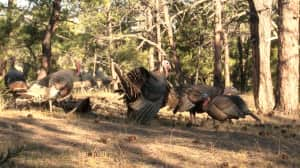Strange Sounds from the Turkey Decoy Spread
Brooks Johnson 02.28.12

Turkeys decoys are visual, add the right sounds
Turkey decoys work best if you couple the visual attractant with natural sounds. While most hunters only use yelps and clucks in their turkey tactics, many other sounds should be employed when hunting turkeys. I guarantee you a hen turkey makes a lot more noise scratching than she does yelping, and you should do the same. Watch the turkeys feed and mock the cadence of their feet scratching the ground, scratch scratch scratch, peck peck peck peck. That is the noise a hen makes all day long, and gobblers recognize it as natural. The scratching involves motion on your part, and a blind works best to shield that movement from mature toms as they approach. It is a tremendously successful turkey tactic when birds hang up at 50 or 100 yards. Trust me, they can hear it.
Turkey decoys or just parts?
A lot of people made fun of ‘the wing’ when Primos came out with it, but the tactic is solid. I usually use my ball cap instead, but the sounds of a turkeys wing can make the difference between a dead gobbler and a noisy one. Fly down is the obvious time to make the sound of a flapping wing, but it is not the only time. Prior to fly down, turkeys do a lot of adjusting and preening on the limb. Mock this sound by dragging some primary wing feathers on the bark of a tree. Don’t over-do it, but a little of these before your fly down noises adds realism, and may be the ticket to getting that gobbler inside your turkey decoys.

A good fight brings them to your turkey decoys
The sounds of a turkey’s wings are always present during a good turkey fight. The wing slap is a turkey’s version of a punch, and if you ever get to feel it, you will remember it. I had a hen wing me in the cheek on a relocate and it hurts like a son of a %$^&*. Combine intermittent ‘wing punches’ with aggressive fighting purrs to bring big toms on a run to your turkey decoys. One of the best times to use this turkey tactic is when you have a bird responding, but can’t get him to budge. A couple gobbles, some heavy fighting purrs, and simulated wing slaps are too much for many toms to take. You are on their turf, fighting to see who the boss is and it does not sit well with a dominant gobbler. It is a better turkey tactic early when they toms are still fighting frequently, and less effective as the season wears on because the toms are tired and less inclined to battle.
You can also make some occasional wing noise to simulate the ‘stretch’ turkeys do throughout the day. By stretch I mean they stand up and flap their wings three or four times, similar to when we yawn and stretch our arms out. Try it when a tom is out of sight, as it is a very visual display, and if they can’t see it when they should it may arouse suspicion.
I use these subtle turkey tactics all season long in conjunction with my jake and hen turkey decoys. The soft noises work better when the birds are close, as they are very natural and can put suspicious birds at ease. Scratching and soft, soft purrs are all I will use inside 75 yards. Real hens seldom squawk their heads off all day long, and neither should you once that tom gets close. Settle down and use the soft natural noises of a hen turkey to get that big black bird into your turkey decoys.

